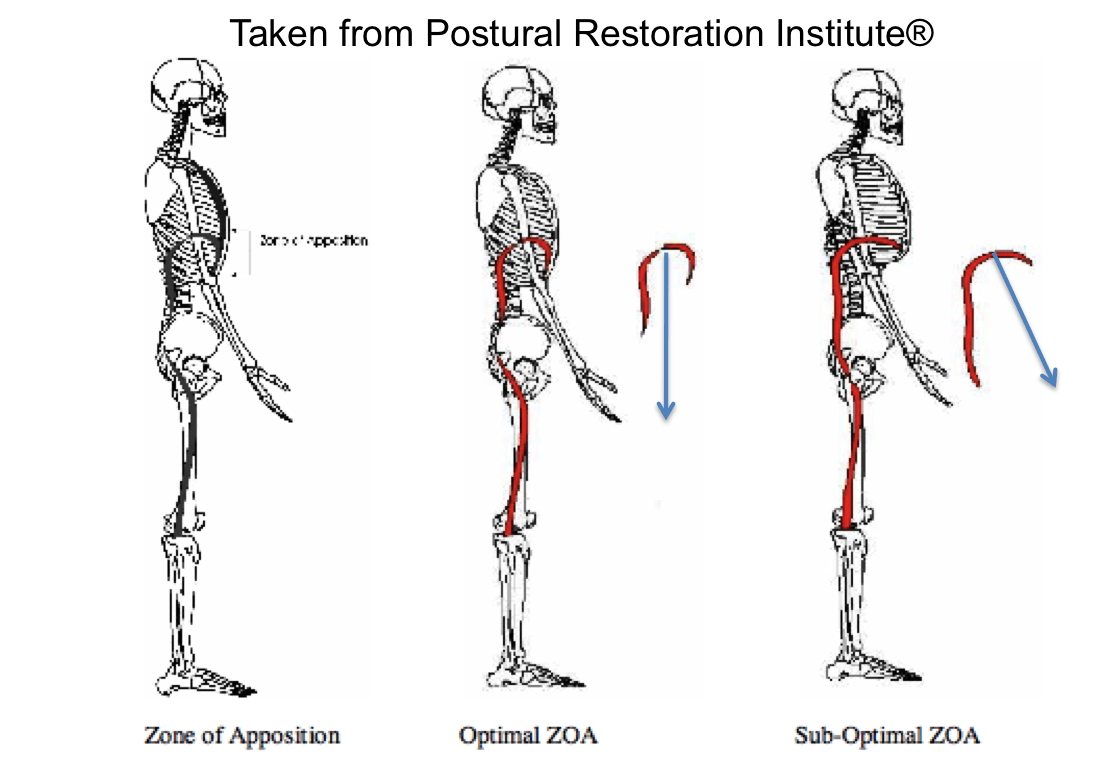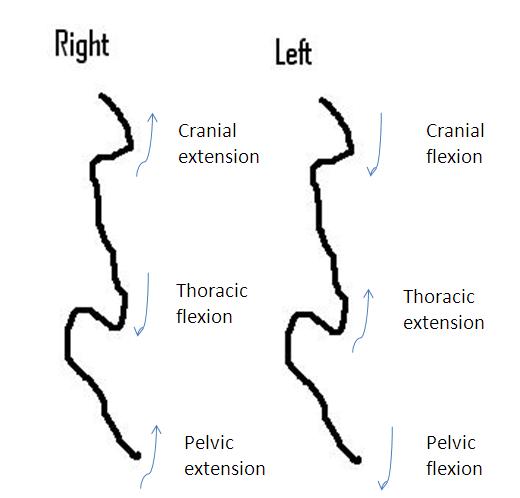Table of Contents
Mind Blown
My mind is still racing from PRI’s annual Advanced Integration course. It is over these four days that we linked all the chains learned in the basic courses into one interdependent system. As I have not taken all the PRI courses yet, I was very fortunate to have Bill Hartman, Doug Kechijian, and Young Matt to help me through the rough patches.
Courses are so much more enriching when taken with friends.
There was way too much material covered over the four days to write in one post. So here is the first of a four part series on this excellent class. Read on.
Autonomics and the ZOA
The first day’s primary objective was establishing a zone of apposition (ZOA), the diaphragm’s cylindrical aspect that lies along the chest wall. Establishing this zone is of utmost importance, as it allows for favorable respiration.

Respiration influences movement by allowing better change of direction and variability. If I establish and maintain a ZOA, then I can effortlessly maximize movement in all three planes. When I cannot perform in this way, then I have less triplanar activity when I move.
When one does not establish a ZOA, one must greater rely on the autonomic nervous system (ANS). Depending on what your goal is, this shift can be well and good. Take an example I got from Bill and my friend Eric Oetter. A sprinter or powerlifter who moves in one direction would not like much variability in how they move, thus triplanar activity in their sport could be disadvantageous. Conversely, a basketball player or dancer needs to be able to move in multiple planes in unpredictable fashions. These athletes may benefit more from being successful movers in multiple planes.
If you fall too far in one direction of the ANS, problems may rise. Too far sympathetic, and you can never shut down and rest. Too far parasympathetic and you cannot power up when you need to.
The ultimate goal is to be off when you need to be off and on when you need to be on.
The reasons above are why PRI emphasizes flexion so much. When I have the ability to flex, I have greater variability to change. In extension, movement blocks more likely occur. If you think about the human body, how many joint’s closed packed positions involve extension? Answer: the entire spine, the hip, the knee, and most of the elbow and wrist that I can think of. If we look at the spine in particular as the governor of how much the appendicular skeleton moves, one relying on too much extension will not be able to utilize any other planar motion.
I want to flex myself out of an extended sympathetic state to ensure movement freedom. The way I can achieve variability, achieve function, is through breathing. Breathing is what allows us to less rely on structural closed packed positions for movement, and function favorably in a triplanar fashion.
The Human Chain
The human body is composed predominately of chambers. These chambers regulate change. But in order to change, one must be asymmetrical. In gait for example, if I were completely symmetrical I would have to hop to walk. Thus, movement has to start within an anatomical asymmetrical position. Asymmetry is good and normal. And if someone is completely symmetrical (a PEC per PRI terminology), some asymmetry must be introduced.
The human chain, the human system, is composed of two alternating reciprocal sides; a left and a right. If talking sagittal plane alone, the chains look as below.

In an asymmetrical human being, each chain is reciprocal because the chains can reverse position. For example, the extended pelvis on the right can flex, the flexed cranium on the left can extend, etc. The ability to alternate means that you can seamlessly switch activity between the left and right side.
Oftentimes in PRI, we talk about the concept of neutrality. Neutrality is only the midpoint between these two chains. It is a prerequisite to allowing alternation between the left and right side. Neutrality is not the goal unless you are not moving. It is merely the gate that allows you to move from the left and the right.
Septums
Setpa are what separate chambers, like a partition. These septa allow for oscillation within chambers and give you internal structure.
These septa and chambers are present structurally secondarily to internal organs. For example, the reason the right diaphragm is larger than the left is because the liver is located directly below the right.
Because the organs create these structures, they must also structure planes of motion within chambers. Muscles are present to mobilize these chambers via the planes. And when a plane of motion is lost, your body twists and torques septa to increase support. This planar loss is part of the reason why the PRI patterns are the way they are.
Septa are found throughout the body, but the most obvious example is the septum transversum; more commonly known as the diaphragm. The diaphragm is was separates the thoracic and abdominal chambers, and allows for oscillation between these chambers.
There are several diaphragms throughout the body, and it is here we must establish ZOAs. The big three ZOAs that need to be established involve three chambers: the pelvis, the thorax, and the cranium; aka the snow man.
These multiple target areas posit the question: which to prioritize first? And basic rule to neutrality involves establishing the pelvis, then the thorax, and lastly the cranium. If one cannot be established after getting others, then that is the one you must go after. Your PRI testing will help you figure out where you need to go.
Establishing ZOA
A ZOA can be achieved predominately by pausing after an exhale. Oftentimes, forced exhalation is utilized to create a zone, but hard expiration is not necessary. All an exhale needs to be able to do is flex, adduct, and internally rotated on the left so a ZOA is achieved via internal obliques and transversus abdominis.
Once you achieve and maintain a ZOA, just breathe and move.
There are several factors that go into with or not a ZOA can be established and maintained. When designing a program, ZOA establishment can be affected by the following:
- Left abdominal obliques and transversus abdominis
- Left acetabulofemoral internal rotation position.
- Neutral temporal fossa position
- Right medial longitudinal arch support
- Adequate left femoral, right humeral, and left temporal internal rotation.
- Neuromuscular reciprocal alternating activity on the sacrum, sternum, and sphenoid.
- Full left humeroglenoid flexion and horizontal abduction.
- Left posterior mediastinal expansion.
- Left pelvic inlet extension
Thus, the aforementioned movements ought to be trained and integrated into alternating reciprocal activity we call gait.
(In)famous Ron Quotes
- “Think System”
- “Before you can move you have to learn how to stop.”
- “I wish I went to a school that said you need your abdominals to poop.”
- “It’s all about wiring [the nervous system]”
- “I, Ron Hruska, love asymmetry. Please tweet that.”
- “If your spine is unstable, thank the good Lord. We want mobile spines.”
- “The neck runs the show and is often the most difficult place to change.”
- “Blow that balloon up to express yourself.”
- “I see a lot of x (e.g back pain), but I don’t see a lot of x.”
- “The right diaphragm is saying I got your back….Literally.”
Stay tuned for day 2.
Zac, thank you for posting these course reviews. I always pick up something new and develop a deeper understanding of the PRI concepts. Eric Cressey introduced me (and Doug K.) to PRI 3 years ago during our CP internship. More recently Conor Ryan got me interested in using PRI with my athletes. It’s a powerful tool. Needless to say I drank the Koolaid.
thanks again for taking the time to post your notes.
Thank you for the kind words Tad. PRI is some of the most powerful stuff I have come across thus far.
I hope you can make it to some courses. Once you get deep enough they give you the whole Koolaid pitcher 🙂
[…] sagittal thoracic motion is normalized, diagonal pattern assistance, coalesced with proper ribcage position, becomes a useful […]